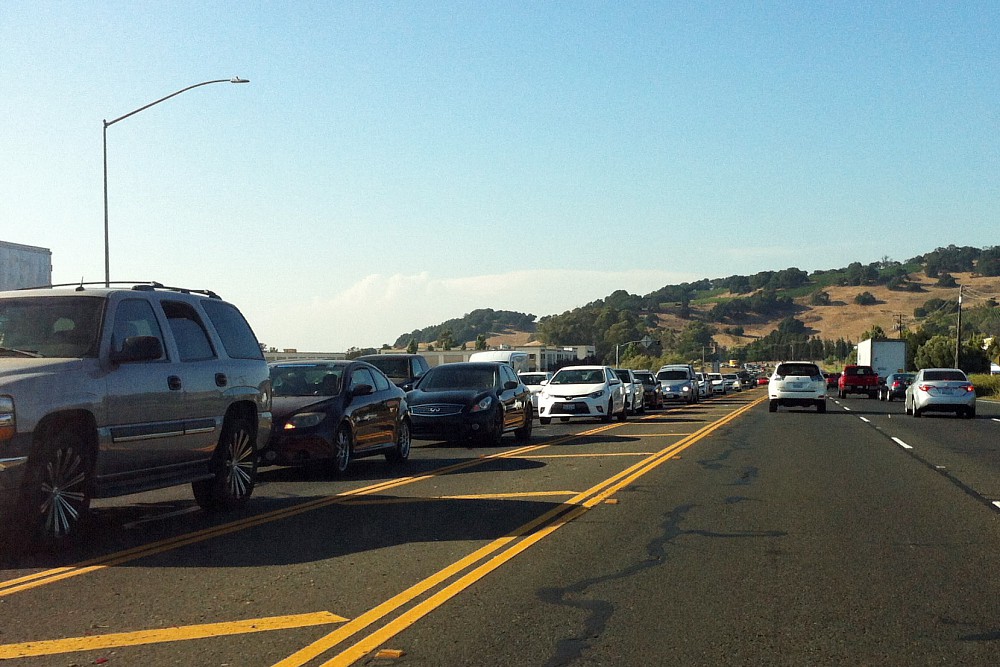
The road not widened (updated)
on the web at: https://sodacanyonroad.org/forum.php?p=1135
Bill Hocker | Jan 14, 2017Update 1/14/17
NVR 1/14/17: Supes choose Pedroza to bring home transportation dollars
The comments below (one of many posts on the SCR Traffic Issues page devoted road widening) highlight why transportation improvements will not relieve the congestion they are touted to fix but will, in fact, cause the pace of urban development to increase, increasing the congestion and eventually encouraging urban uses to swallow up agricultural land. Napa agriculture has survived this long in the bay area because the road widening mania of the 60's and 70's was thwarted by resident vintners and growers interested in preserving their industry and way of life. With the wine industry now dominated by corporations and good-life entrepreneurs promoting tourism, traffic problems have become a major obstacle. Increasing urban development in Napa County is, of course, what Bill Dodd and now Sup. Pedroza were placed in office to do.
12/12/2015
Derek Anderson, running for supervisor against Mark Luce in the 2016 election, has just penned an interesting editorial asking taxpayers to "widen our main transportation arteries thought the valley, from American Canyon to Calistoga" in order to "fix" our traffic problems.
The road widenings necessary to mitigate the anticipated traffic in 2030 were, in fact, enumerated on this page of the draft environmental impact report (obtained by George Caloyannidis) prepared prior to the 2008 modification of the County General Plan Circulation Element. (This element is currently again under review by the County.) To achieve an "LOS D" level of service in 2030 (on an A-F scale) the following road widths would be needed:
Southern Crossing - 8 lanes
Hwy 29 - 6 lanes throughout
Silverado Trail - 4 lanes throughout
Soscol from 29 to downtown- 6 lanes
American Canyon Rd - 6 lanes
Six Flags to Am Can Rd - 6 lanes
Green Island Rd - 6 lanes
Deer Park to Angwin - 4 lanes
Hwy 128 - 4 lanes throughout
The DEIR rejected these mitigations saying "While the above roadway improvements would reduce the peak hour and daily levels of service to acceptable levels, [these] improvements are not considered feasible given the environmental effects associated with the roadway widening and these improvements world be inconsistent with the vision set forth in the General Plan Update. The following statement from the Summary and Vision section of the proposed General Plan Update summarizes the Coutny's provisions: ' This General Plan will preserve and improve the quality of life and the rural character of the County by proactively addressing land use, traffic, and safety concerns in addition to sustaining the agricultural industry.' Widening of these roadways would result in more severe environmental impacts (beyond what is addressed in this DEIR) associated with visual resources, water quality, noise, air quality and growth inducement."
In all probability the wine industry exists because of road widenings that were opposed in the 1970's, leaving only the orphaned stretch of freeway along the west side of Napa CIty, the only bit of freeway in the county. While road improvements are often promoted as relieving congestion, their actual function is to make further development possible and inevitable. (We need only look at the recent widening of Jameson Canyon and its impact on the intersection with Hwy 29 pictured in the map at the top of the page, or the 29/Trancas underpass, to realize that widenings don't relieve congestion - they just bring more traffic.)
Had freeways been built into and through the valley as originally envisioned it is highly unlikely that the agricultural use of the land could have held out against the pressure for more urban development. The people and government of Napa county have long recognized the role of road building as a precursor to urban development and wisely shunned it even in the knowledge that, as the 2007 DEIR indicated, the unmitigated impact of traffic congestion will result.
In Mr. Anderson's call for road widenings, we begin to see the shift in development interests that continuing tourism development is beginning to bring. While traffic congestion affects all, it has become a major impediment for the growth of the tourism industry, a constant complaint in travel articles written about the county. So far many vintners seem to believe that they can have it both ways, the financial benefits of ever increasing tourism without a development impact on the agricultural resource that is the base of their industry. They feel that the development impacts can be contained with in the RUL's of the municipalities while they continue to develop their wineries, pretending that their new buildings and parking lots are a part of an agricultural process, when they are in fact an urban expansion of tourism venues into the vineyards. The need for more wineries to process Napa grapes has long been fulfilled. The need for more roads to access the ever increasing winery venues is becoming critical to the tourism industry.
There is a need for alternatives to begin to confront the congestion we have, a light rail system, a realistic bus system, worker or tourist shuttle systems (and not helicopters!). But those will only help if the amount of development currently occurring stops. Just as with road widenings, transport systems will never keep up with developers. It is time to visualize a stable economy and amount of development that the county's agriculture can support, and reject an ever expanding economy that will eventually consume agricultural land to keep the expansion going.
The call for road widenings is not really to relieve existing congestion but to allow further tourism development to proceed. A cascade of further development will come in its wake. The traffic problems will never be "fixed". If Mr. Anderson's vision of road building is realized, as has been feared and rejected in the 1970's through 2007, it will be the end of Napa's great experiment in maintaining an agricultural preserve in an urban world.
copyright © sodacanyonroad.org
